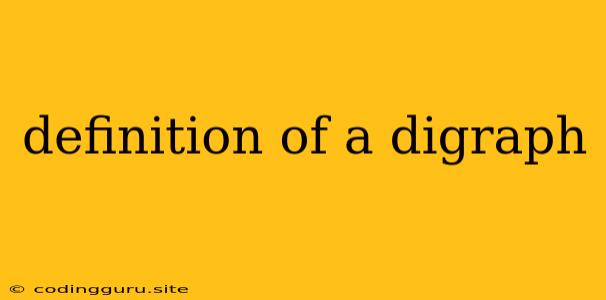What is a Digraph?
A digraph is a fundamental concept in graph theory representing a relationship between objects where the direction of the relationship matters. In essence, a digraph is a graph where each edge has a specific direction, indicating a one-way connection between two vertices. This directional aspect distinguishes it from an undirected graph where edges represent bidirectional connections.
Imagine a network of roads where you can travel only in one direction on each road. This network can be represented using a digraph, with cities as vertices and roads as directed edges. If you can travel from city A to city B but not the other way around, the edge connecting them would be directed from A to B.
How is a Digraph Represented?
A digraph can be represented in various ways, including:
- Adjacency Matrix: A matrix where rows and columns represent vertices. An entry in the matrix is 1 if there's a directed edge from the corresponding row vertex to the column vertex, and 0 otherwise.
- Adjacency List: Each vertex is associated with a list of vertices connected to it by directed edges.
- Edge List: A list of ordered pairs representing directed edges. Each pair (u, v) indicates an edge directed from vertex u to vertex v.
Understanding the Importance of Digraphs
Digraphs find applications in various fields, including:
- Computer Science: Representing program flow, network topologies, and data dependencies.
- Operations Research: Modeling transportation networks, resource allocation, and scheduling problems.
- Social Networks: Representing relationships between users, such as followers, friendships, or communication channels.
- Biology: Modeling genetic networks, protein interactions, and ecological relationships.
Distinguishing Digraphs from Undirected Graphs
While digraphs and undirected graphs both represent relationships between objects, they differ in the directionality of the connections.
- Undirected Graphs: Edges represent bidirectional relationships. For example, a friendship between two people is represented as an undirected edge connecting their corresponding vertices.
- Digraphs: Edges represent unidirectional relationships. For example, a "follows" relationship on social media is represented as a directed edge from the follower to the followed person.
Types of Digraphs
Different types of digraphs exist based on their specific properties:
- Simple Digraph: A digraph without loops (edges from a vertex to itself) or multiple edges connecting the same pair of vertices.
- Multigraph: A digraph where multiple edges connecting the same pair of vertices are allowed.
- Tournament: A complete digraph where every pair of vertices is connected by exactly one directed edge.
- Acyclic Digraph: A digraph without cycles.
Examples of Digraphs in Real Life
- Road Networks: A digraph can represent a road network, with cities as vertices and roads as directed edges. One-way streets would be represented as directed edges, while two-way streets would be represented as two directed edges in opposite directions.
- Social Networks: A digraph can represent social networks, with users as vertices and connections as directed edges. A directed edge from user A to user B would indicate that user A follows user B.
- Gene Regulatory Networks: A digraph can represent gene regulatory networks, with genes as vertices and regulatory interactions as directed edges. A directed edge from gene A to gene B would indicate that gene A regulates the expression of gene B.
Conclusion
Digraphs are a powerful tool for representing relationships with directionality. They provide a versatile framework for modeling and analyzing various systems and processes in computer science, operations research, social networks, and other fields. Understanding the concept of a digraph is crucial for working with graph algorithms, data structures, and various real-world applications involving directed relationships.
